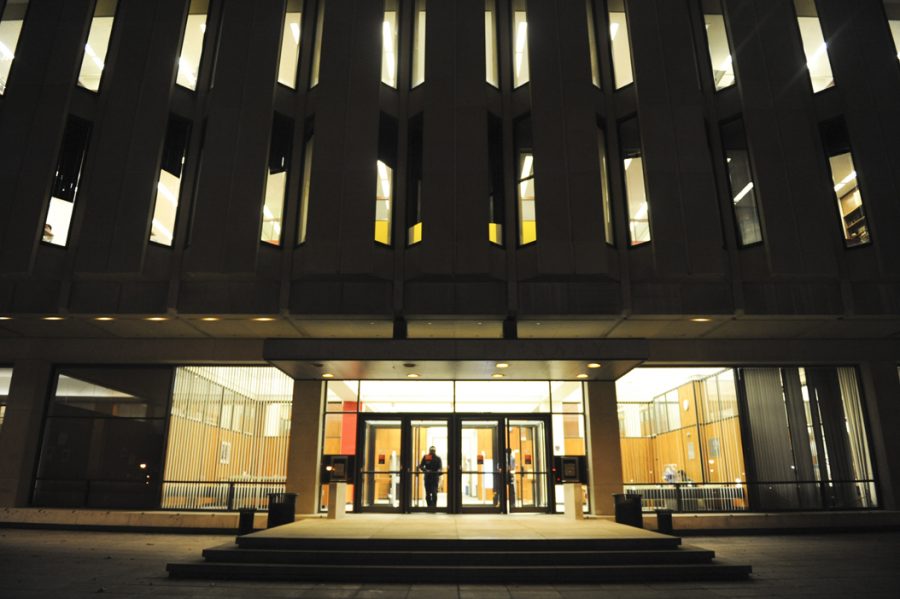‘Student Voices: Creating a Place of Belonging’ exhibit presented on media wall in Hillman Library
Hillman Library at night.
January 12, 2023
Students use Pitt libraries for many reasons — to conduct research, work on group projects or simply to do homework. Pitt librarians, such as Berenika Webster, want to improve these multi-use spaces for students and create a sense of belonging in campus libraries.
A team of Pitt librarians — Webster, Diana Dill, Renee Kiner and Leslie Poljak — started the Belonging at Pitt Libraries research project in spring 2022. According to Webster, the director of assessment and quality assurance in the University Library System, the project enlisted student perspectives on how to create a sense of belonging in Pitt’s libraries.
The four librarians first displayed the findings of this project in an exhibit titled “Student Voices: Creating a Place of Belonging” at the end of November. The exhibit, presented on the interactive media wall on the third floor of Hillman Library, includes photographs collected by students along with design ideas for spaces. According to Poljak, the outreach and engagement librarian, the exhibit will also be available online in the coming months.
Poljak said about 30 students participated in the Belonging at Pitt Libraries project. Students who participated used a research method known as “photo voice,” which uses pictures to collect and analyze data. According to Webster, students took pictures of any public spaces in their community where they felt a sense of belonging, along with spaces where they did not feel welcomed.
The student participants had two weeks to take pictures at the beginning of March 2022. Later that month, students chose one of three time slots to attend a virtual discussion group analyzing the photos.
Poljak said the librarians who created the exhibit participated in all three discussion groups and identified four themes of spaces where students felt a sense of belonging. The interactive exhibit in the library includes images from students that coincide with each theme.
“During the discussion groups, students were trying to classify these photographs and find common themes within those images,” Webster said. “We tried to find themes that would make the space safe, welcoming and that students felt like they belonged in that space.”
The foundational theme, according to Webster, is physical safety.
“This is a kind of prerequisite to any changes of feeling welcome in a space,” Webster said. “Some of the characteristics are the feeling of protection and familiarity.”
Webster said the next theme, emotional well-being, includes ample lighting, access to fresh air, an indoor-outdoor atmosphere, biophilia and greenery in spaces and access to food and drink. The third theme, emotional safety, involves students feeling that they are participating in a shared experience, according to Webster.
“Students want to be surrounded by people that are doing similar things,” Webster said. “If you are studying for exams, you want to see other people studying for exams.”
Webster said the fourth theme, the feeling of ownership, consists of students feeling that they “truly belong” in the space.
After the librarians identified these themes, Poljak said the next step in the project was translating the findings into designs that could be applied in library spaces. An undergraduate student, Matthew Cohn, sat in on all discussion groups and used findings to create design concepts that would capture each of the four themes.
Cohn, a senior architecture studies and economics major, created various illustrations capturing qualities of “belonging” defined during the study. Cohn said he used the information from the focus groups to guide his graphics.
“At the end of the day, I used this information to generate and understand what ‘belonging’ means,” Cohn said. “The other purpose of the graphics was so that they may be implemented as a design guide and reference when the University Library System expands and/or renovates spaces.”
According to Cohn, he learned “a great deal” about how people feel in spaces through participating in the project.
“During the focus groups, I was able to hear a lot of opinions about locations around campus,” Cohn said. “Probably the most polarizing was Hillman. Some people like it, some people hate it.”
Poljak said while the Hillman construction is not yet complete, she and other librarians still want to incorporate a feeling of belonging in library spaces.
“We want to create a sense of community,” Poljak said. “Having student-curated exhibits and artwork creates more of a sense of ownership of a space on campus.”
According to Webster, one way to create a sense of belonging in the library is to engage students in providing content to display on Hillman’s digital walls. While there is currently only one digital wall in Hillman, Webster said there will eventually be a digital wall on the second and ground floors.
“We would like to make sure that students can share their research, showcase their work,” Webster said. “We want to engage them through giving them space.”
Findings from this study not only prompted ideas for changes in Hillman, but also in the engineering library. Webster said a similar project to this will start soon to evaluate the redesign of the engineering library.








